Zacusca, the Romanian vegetable spread I adore, becomes a staple in my kitchen every year as summer fades. It's a delightful mix of roasted eggplants and peppers combined with fresh tomatoes and onions, all simmered slowly to reach that perfect flavor.
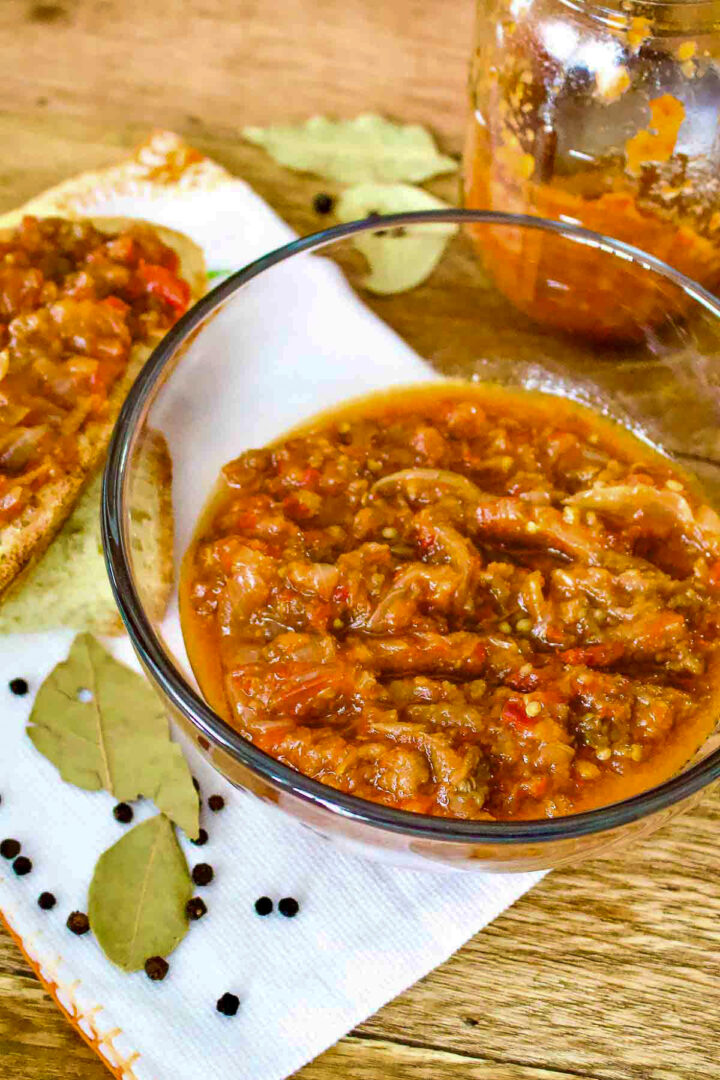
There's something magical about the end of summer in Romania, a tradition that captures the essence of the season's bounty in a jar: Zacusca. This Romanian vegetable spread is not just food; it's a celebration of flavors, a testament to the ingenuity of preserving summer's best, and a personal ritual I cherish deeply.
Jump to:
Why You Will Love This Recipe
As the crisp air of winter begins to unfold, Zacusca brings warmth and comfort to our tables. It is a versatile spread that pairs wonderfully with fresh bread, cheeses, and cold cuts, making it a perfect appetizer or a hearty meal in itself.
Beyond its delicious taste, Zacusca allows us to taste the summer in the depth of winter, connecting us with nature's cycles and the joy of homemade preserves.
Most Eastern European countries have a version of this spread. In some countries, the spread has more peppers and no eggplants. In other countries, they use more tomatoes and fewer peppers.
Key Ingredients
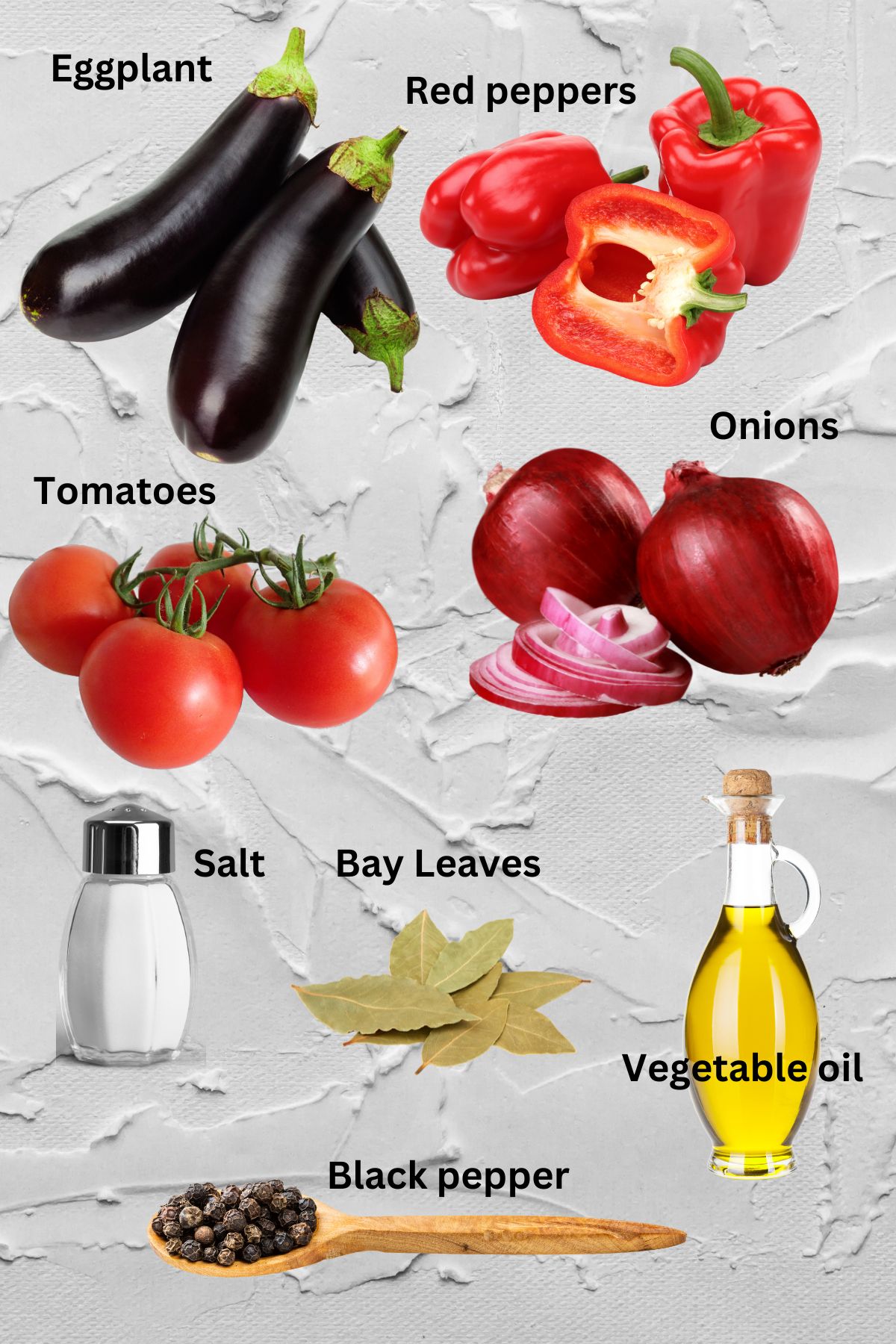
- Eggplants and Peppers: The heart and soul of Zacusca, roasted to perfection.
- Tomatoes and Onions: For that tangy sweetness and depth of flavor. Juicy tomatoes are perfect for this dish, but tomato sauce or even tomato puree is accepted. Use red or white onions.
- Variations: While my kitchen honors the classic eggplant version, variations abound across Eastern Europe, with some opting for more peppers and others for beans, zucchini, or mushrooms, each adding a unique twist to this beloved spread.
Making Zacusca, the beloved Romanian vegetable spread, requires some elbow grease. I won't sugarcoat it; preparing this dish demands time and dedication. But for those willing to invest the effort, the reward is a delectable batch of Zacusca.
Historically, this spread was a winter staple, a clever solution to the absence of fresh vegetables during the cold months, much like the canning traditions familiar to many Americans before the age of industrial food production. Canning, a somewhat lost art, is not just economical but also a way to ensure your pantry is stocked with nutritious, homemade food where you control the ingredients.
The cornerstone of this spread is its roasted vegetables, with eggplants playing a starring role. Let me explain step by step how to prepare each of these ingredients. Let me start with eggplants, as they are the heart of this Zacusca spread.
Step-by-Step Instructions
How to Cook Eggplants For Zacusca
Cooking eggplants is an art that varies by method, season, and personal preference. Whether you're aiming to prepare them for dips, salads, or the star of our show, Zacusca, mastering the cooking of eggplants can transform your dishes.
Exploring Different Methods
Eggplants can be cooked in several ways, each bringing out a unique flavor and texture suited to your culinary needs. From grilling over an open flame for that unmistakable smoky taste to baking them in the oven for a softer, more subdued flavor, the choice depends on what you have at hand and the time of year.
Grilling: A Personal Favorite
My go-to method for Zacusca is to grill the eggplants on a fire grill. This technique imparts a rich, smoky depth that is simply irreplaceable in this spread. If you're curious about other methods, especially when a fire grill isn't an option, I encourage exploring further. Each method has its place and can yield delicious results, suitable for a variety of dishes, including an eggplant salad that's just divine.
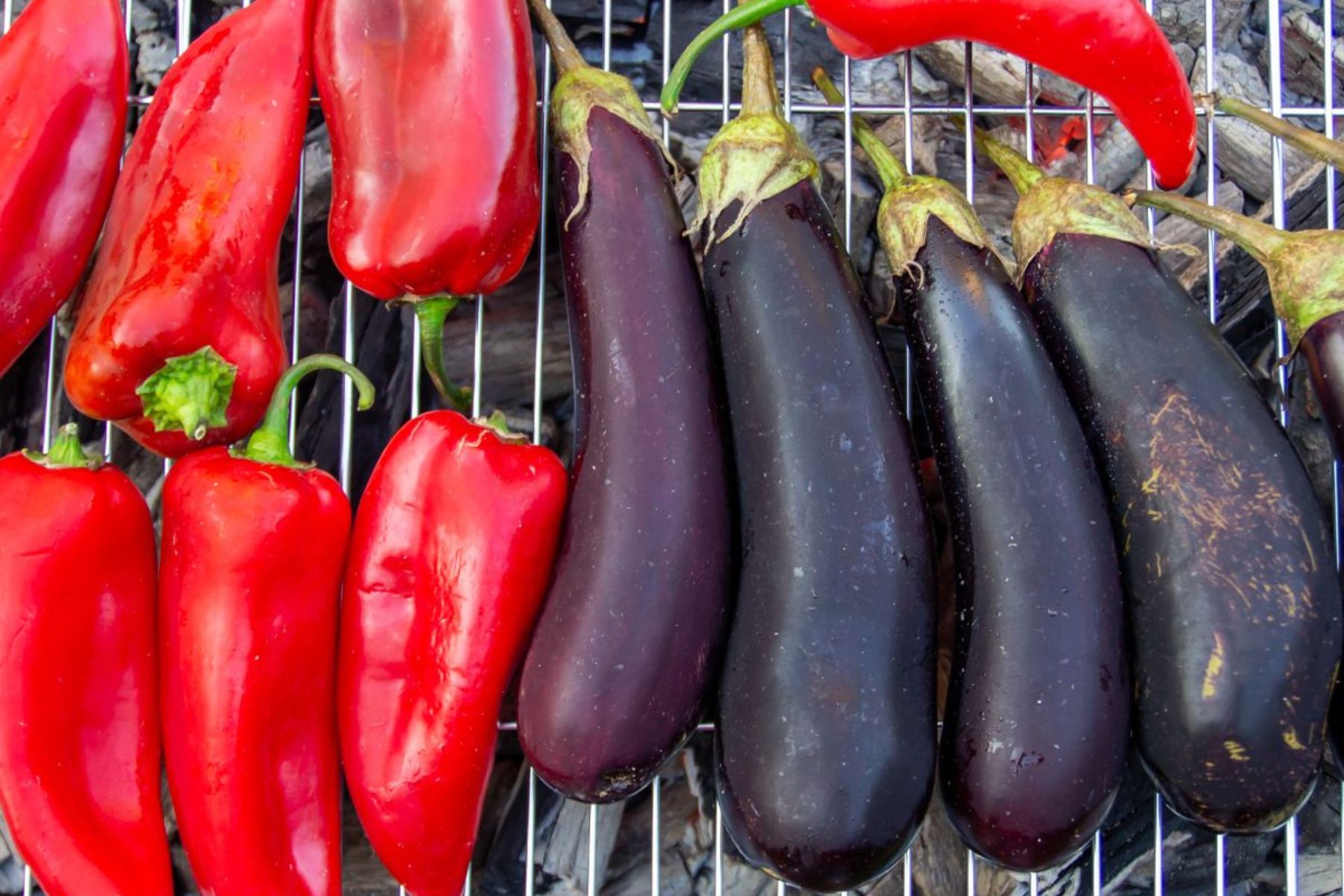
Preparing the Eggplant
Once your eggplants are cooked to perfection—be it grilled, roasted, or baked—let them cool before peeling off the skin. This step is crucial for removing any bitterness.
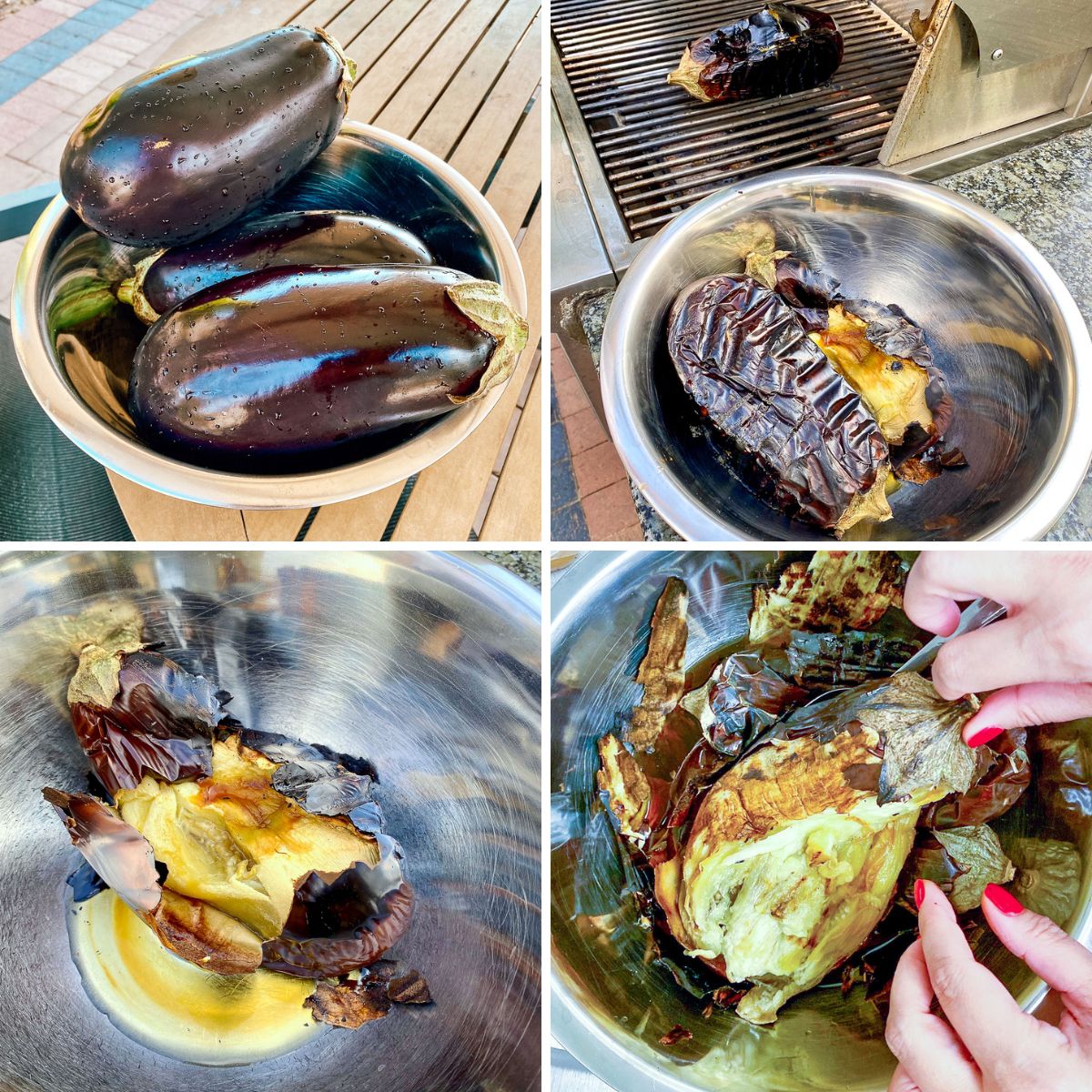
Drain the eggplants in a strainer for about 30 to 60 minutes to ensure all excess moisture is gone. Then, it's time to chop.
Traditionally, in Romania, we use a special wooden or plastic knife for this task to prevent oxidation, which could potentially affect the color of the dish. However, modern stainless steel knives work just as well without impacting the eggplant's appearance.
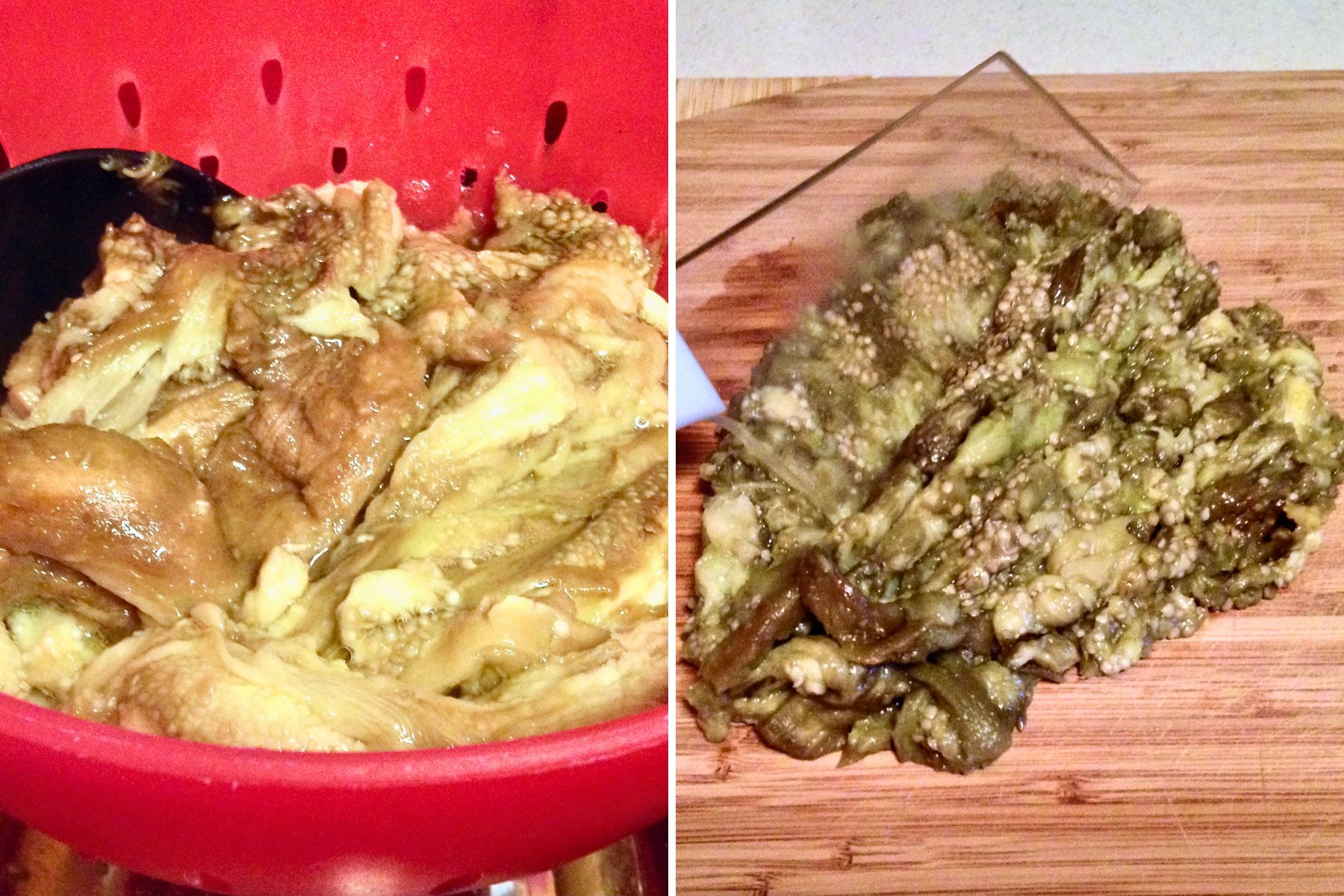
While a food processor might offer convenience and a smoother texture, I find that hand-chopping provides a more rustic, authentic feel to the spread. The texture is all up to personal preference—finely chopped for a smoother spread or left a bit chunky for some added bite.
After chopping, set the eggplants aside as you prepare for the next steps in your Zacusca-making journey.
How to Grill Peppers
Peppers are best charred over direct heat, peeled, and then sliced or chopped.
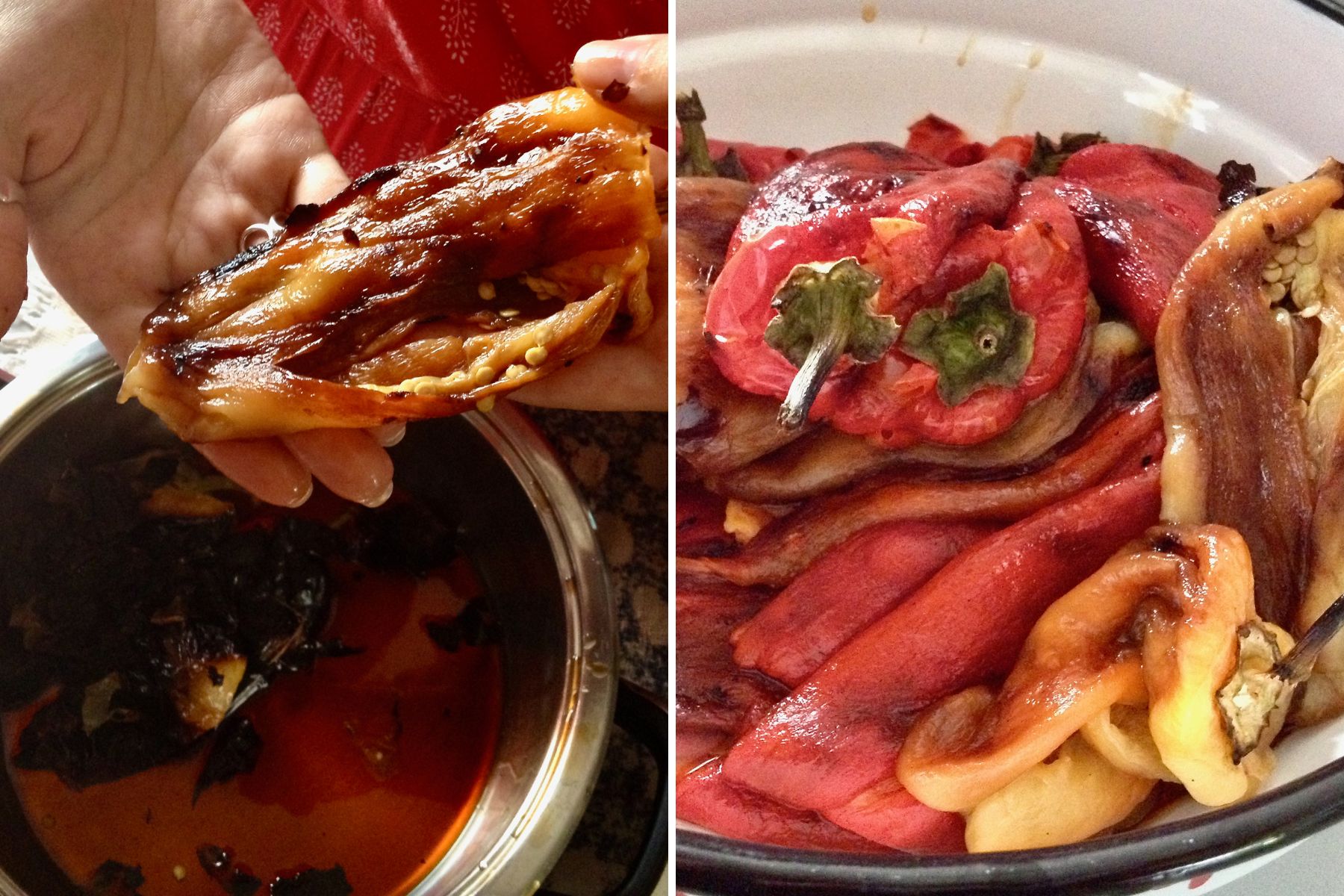
This process adds another layer of texture to the Zacusca.
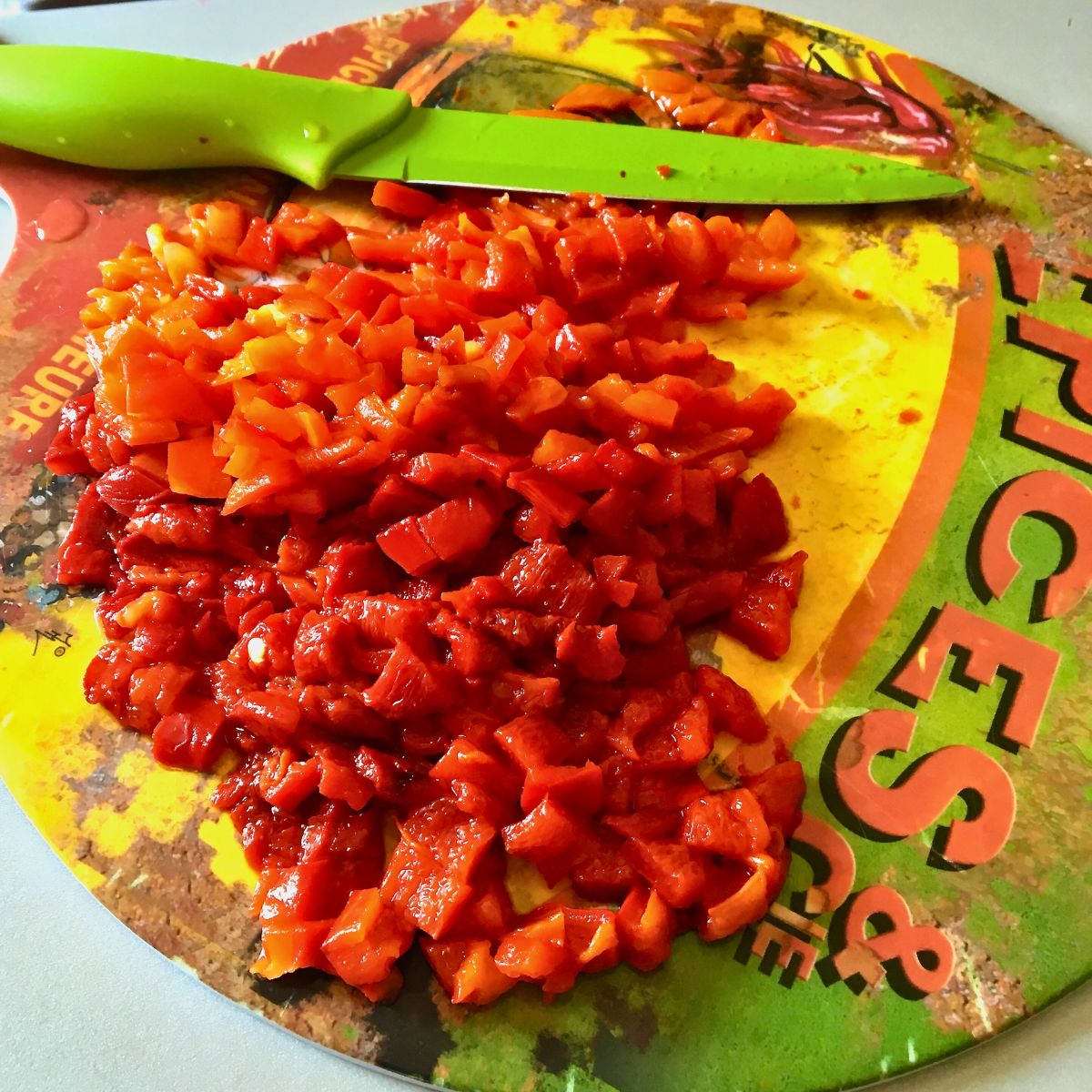
How To Assemble
First, this vegetable spread is made in large pans that have a large surface for the liquids to evaporate. This way, the spread will be thicker and more delicious, not soupy.
The pan sits on the stove on lower heat and needs to be supervised at all times. You also need to stir in the pan most of the time to make sure nothing sticks to the bottom.
Step 1. Cook the onions. We start with the onions by slicing them Julienne. In a large pan, place the oil and heat it up on the stove on medium heat. Add the sliced onions and cook them slowly on medium-low heat.
Stir once in a while and let them cook until they become translucent. Add salt and pepper. Lots of pepper, as you have a large amount of onions.
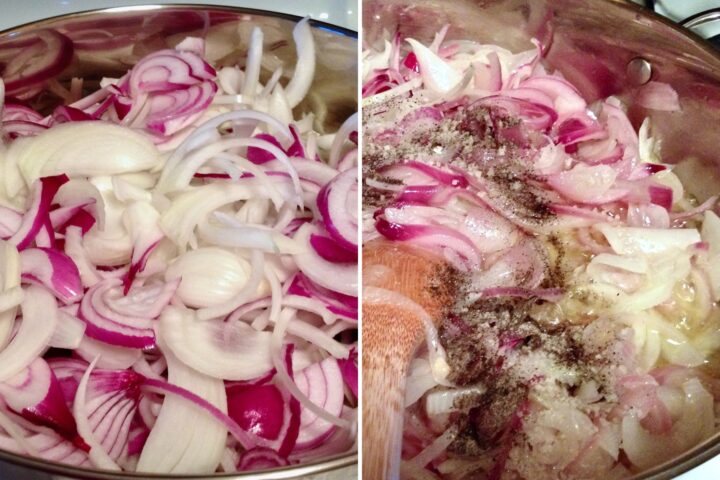
Step 2. Roasted peppers and eggplants. When you get to this step, add the roasted peppers and chopped eggplant and stir again.
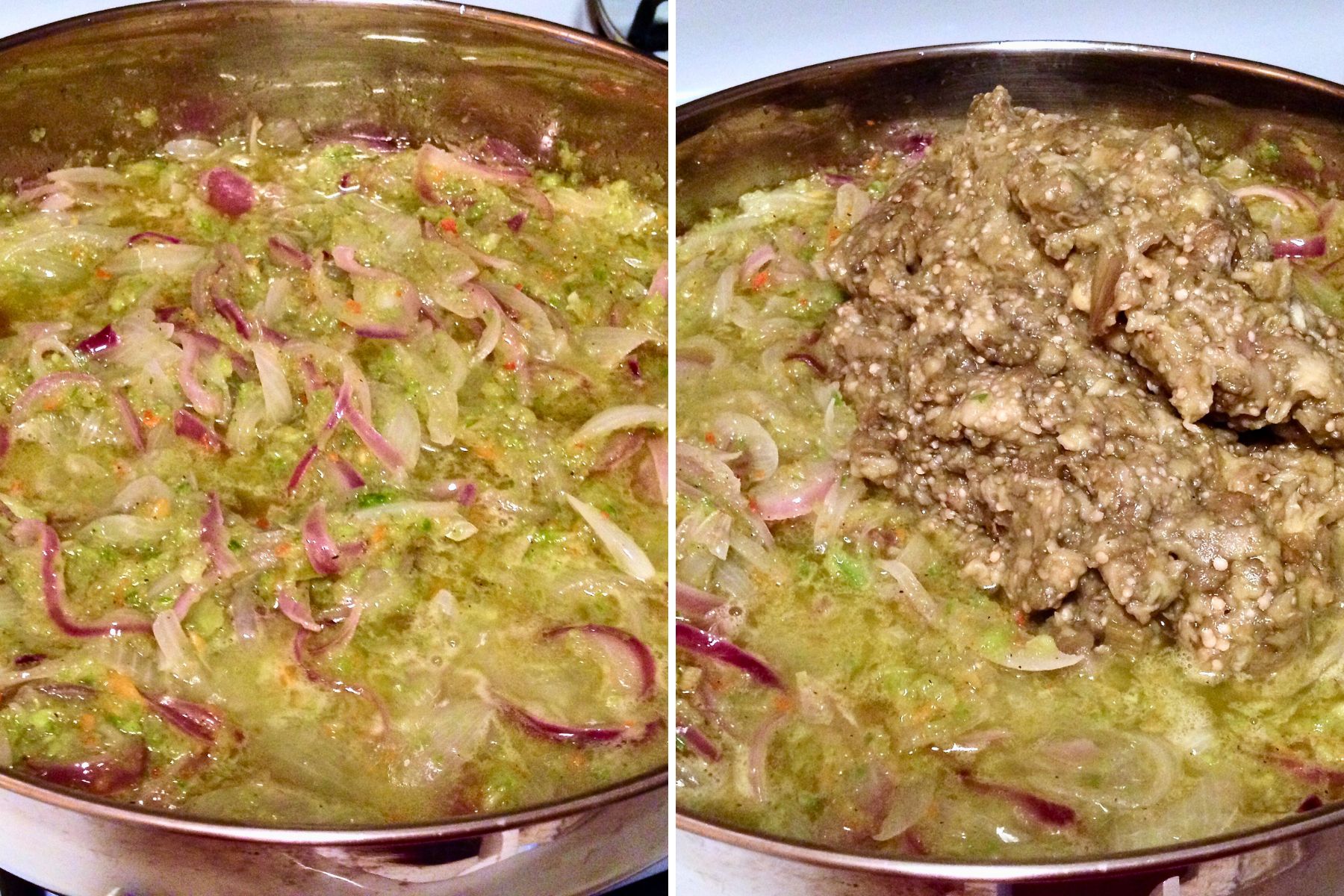
Step 3. Tomatoes and bay leaves. Add bay leaves and, finally, the tomato sauce.
In the summer, I use tomatoes from the Farmer Market that I put in the food processor and make the sauce. If I make this spread late in the fall, when tomatoes are not so great anymore, I buy the tomato sauce or puree and use it the same.
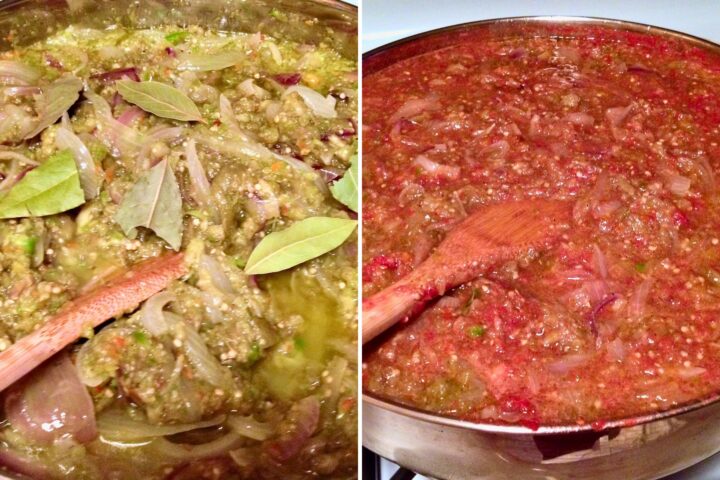
Step 4. Cook. This vegetable mixture is now going to cook slowly on the stove for about an hour while I constantly stir it so it doesn't stick to the bottom. After an hour, I taste for salt and pepper.
Step 5. Bake. At this point, everything goes in the oven for about two hours at 350F/180C. It is ready when it becomes thicker, and the oil floats on top of the vegetables. While the spread is in the oven, I sterilize the jars.
Step 6. Fill the jars and sterilize. The jars and the vegetable spread have to be hot when you fill the jars. I seal them and flip them upside down.
I cover all the jars with a blanket and let them cool down. The next day I preheat the oven to 215F/100C and place the jars upside down on a baking tray inside the oven.
I shut off the oven and leave the jars inside without opening the oven until they cool completely. I remove them from the oven, label and place them in a cool pantry for later use. The spread is good until summer if you don't finish the jars earlier.
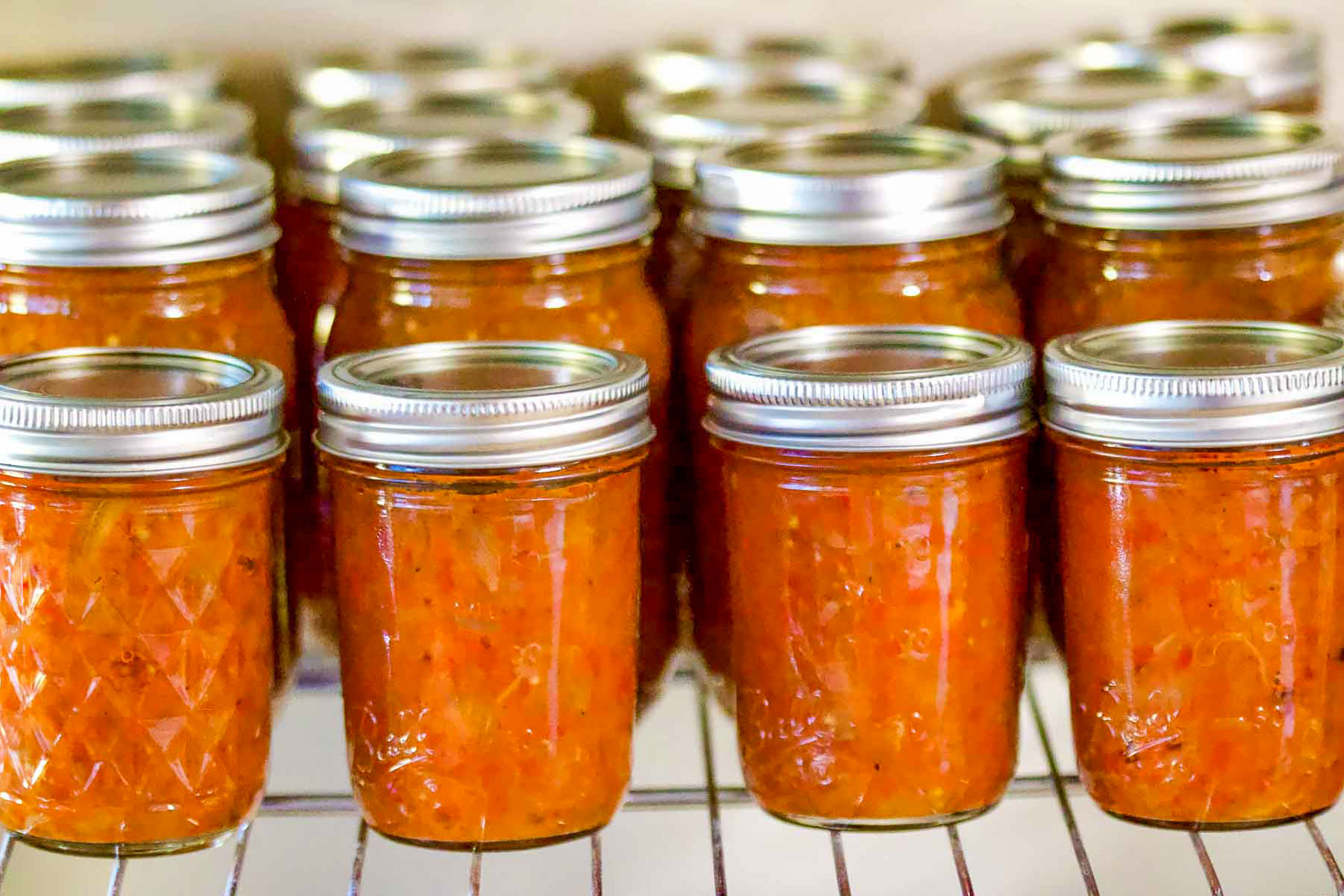
Tips for Perfect Zacusca
- Achieving the Perfect Consistency: The key to perfect Zacusca lies in the slow simmering process, allowing the mixture to thicken and flavors to concentrate.
- Canning: Canning preserves the Zacusca and intensifies its flavors over time, making it a cherished winter staple.
Serving Suggestions
Zacusca shines as a standalone spread on fresh bread but truly comes to life as part of a platter, accompanied by your favorite cheeses, cold cuts, and fresh vegetables.
We like the spread as an appetizer, as I already said earlier, but we also like to take it to work or for lunch. It could also be a light dinner, next to a few slices of good bread or crackers, cold cuts, or good cheese, your favorite. It is the perfect food.
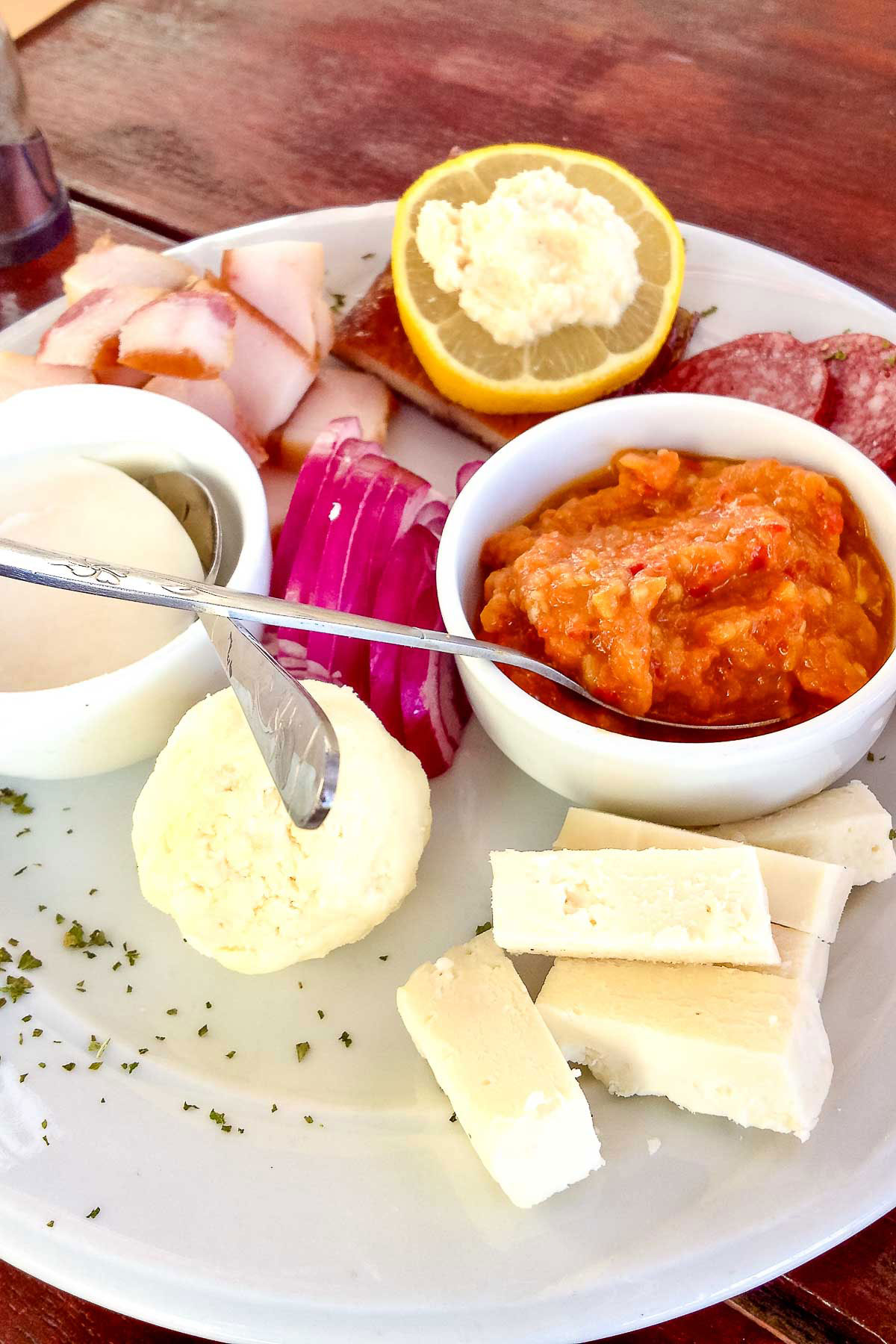
FAQs
Yes, especially outside of tomato season, high-quality canned tomatoes can substitute fresh ones to ensure the spread is delicious year-round.
Properly canned and stored in a cool, dark place, Zacusca can last up to a year, if you can resist it that long!
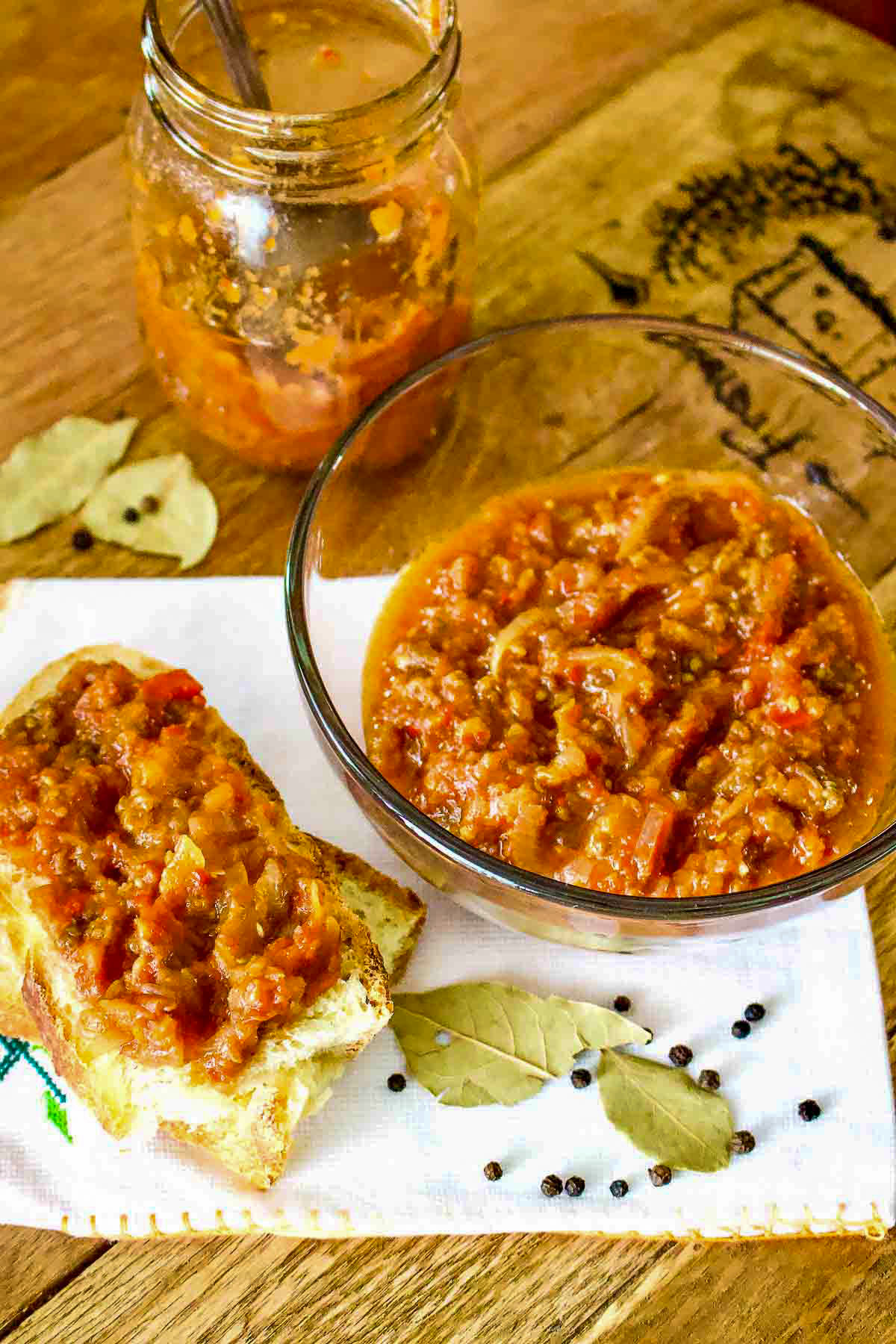
I'd love to see your Zacusca creations and hear your stories. Share your experiences, tips, or questions in the comments below, and don't forget to pin this recipe for later!
More Romanian Recipes To Love
Enjoy!
📖 Recipe

Romanian Vegetable Spread-Zacusca
Ingredients
- 6 pounds eggplants
- 3 pounds red bell peppers or pimientos
- 1 pounds onions could be white, sweet, or red onion
- 17 fl.oz. vegetable oil I used sunflower oil
- 33.8 fl.oz. tomato sauce or puree
- 4 tablespoons salt
- 2 tablespoons ground pepper
- 3-4 bay leaves
Instructions
- Clean the eggplants and the peppers.
- Grill all the eggplants and peppers until they are charred. Peel the skin from both eggplants and peppers and also remove the seeds from the peppers.
- Note:If you choose to roast the eggplants in the oven, place them on a tray, pierce them with a fork and roast them at 400F/200C for about 45 minutes or until the flesh is soft. Remove from the oven and peel the skin off.
- Let the eggplants drain in a colander until no juices come out, at least one to two hours.
- Chop the eggplants and the peppers using a knife or a food processor, whatever you have available. Do not make a paste, pulse just a few times to chop the soft vegetables. If you use a knife, chop everything fine. Set aside.
- Slice the onions. Place a very large pan on the stove and pour the oil in it. Heat up the oil on medium heat and add the chopped onions. Cook them until soft, but make sure to stir in them so they do not burn.
- Add chopped eggplants, peppers and tomato sauce. Add three tablespoons of salt and the pepper and mix well. Add the bay leaves. Taste and add more salt if necessary.
- Note: The heat should be moderate to low and the pan should be supervised at all times. When the vegetable spread starts simmering, lower the heat and continue stirring occasionally to make sure the spread does not stick to the bottom of the pan and burn. Simmer for about an hour on the stove.
- Preheat oven to 350F and move the pan inside the oven for another two hours.
- The spread will be ready in about 3 hours total or when the vegetable oil comes to the surface of the spread.
- How to sterilize the jars and finish the canning: Boil the empty jars in hot water for about 10 minutes. Fill the jars carefully with the hot spread so that there is about an inch left from the top. Seal the jars really well and flip them upside down. Place all of them on a metallic tray and cover the jars with blankets to cool down slowly.
- The next day, preheat oven to 215F and place the tray with the jars inside. Shut down the oven and let the jars inside to cool down completely.
- Another method would be to sterilize the jars in a water bath for 40 minutes.
Notes
- Opt for ripe, juicy tomatoes for the freshest taste. During the off-season, high-quality canned tomatoes can be a great alternative, ensuring your Zacusca is delicious year-round.
- If using canned tomatoes, choose whole, peeled tomatoes for the best flavor and texture. Puree them yourself to control the consistency of the tomato base in your Zacusca.
- Zacusca stores beautifully. Ensure jars are sterilized and sealed properly. Store in a cool, dark place for up to a year. Once opened, keep refrigerated and consume within a week for the best flavor.
- To ensure a seal, fill jars while both the jars and Zacusca are hot. Seal tightly and invert for a vacuum effect as they cool.
- For eggplants, choose ones that are firm and heavy for their size.
- When roasting eggplants and peppers, aim for a charred exterior. This not only makes peeling easier but also enhances the smoky flavor of the Zacusca.
- Draining the roasted eggplants in a colander before chopping helps remove any excess moisture, ensuring your spread is not watery.
- Simmer the mixture on low heat to allow the flavors to meld together without burning. Stir occasionally to prevent sticking.
- Serve Zacusca as a spread on crusty bread, as part of a cheese platter, or as a flavorful addition to sandwiches. It's versatile and pairs well with a variety of dishes.

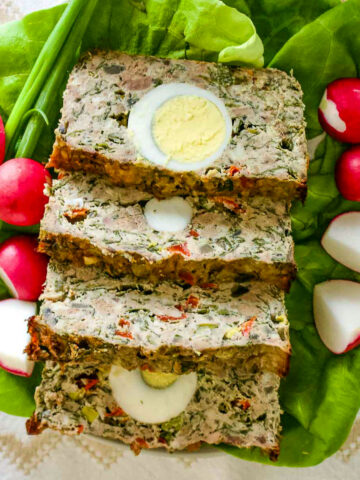



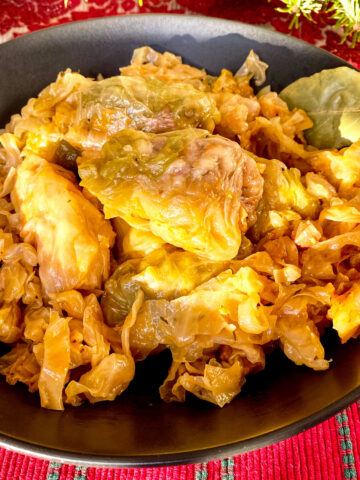

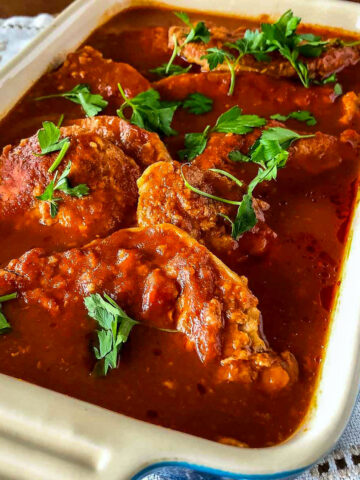
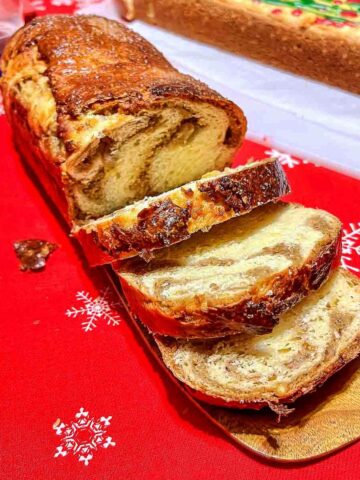
Lucie says
Thank you for sharing this recipe, I am really happy to have found it, I made it twice and have some beautiful canned jars that I can't wait to open for the winter. I did not get 20 pint jars out of one recipe however, and I measured the vegetables with a scale. I got about half that amount. Still very satisfied with the result and will do it again as soon as I gather up enough eggplant!
Liz says
Wondering if there might be different types of eggplant with different weights? I followed the instructions above and got 5 pints in the end, and it seemed perhaps more oily than it was supposed to be.
The Bossy Kitchen says
I am not sure what you mean when you say "different types of eggplant with different weights." The ratio between vegetables and oil is correct, but you can use less oil next time. I would not go for half the amount, but I would use slightly less than a half liter if you think it is too oily. Allow the jars to sit for a few weeks in your pantry, and open one to see how it is.It might be different.